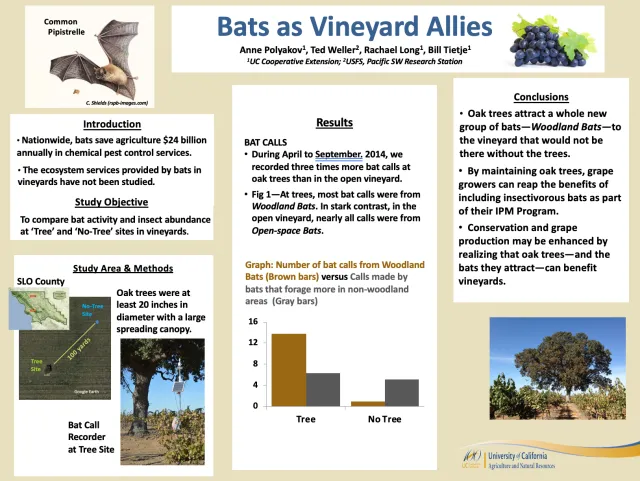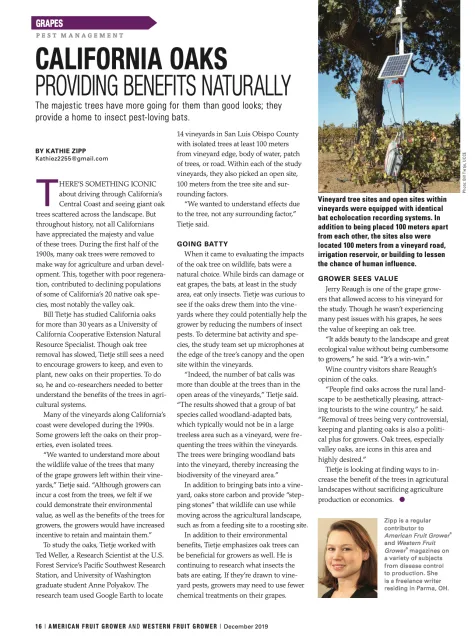Oaks in vineyards a ‘win-win’ for bats and growers
During vineyard development, Central Coast grape growers often feel compelled to leave an old iconic oak standing, even if it ends up right in the middle of their vineyard. While driving through the Central Coast, it’s not unusual to see the pattern of vineyard rows broken by a majestic oak tree. Aside from their beauty, what are some of the ecosystem services that these majestic trees provide?
To find answers, I collaborated with a University of Washington graduate student, and a U.S. Forest Service scientist to study how insectivorous bats use blue oak and valley oak trees in vineyards. Bat populations have declined dramatically in some areas due to habitat loss and disease. Bats don’t hurt grapes. As a matter of fact, thanks to the huge number of bugs they consume, bats could be very good for a vineyard.
To understand the potential value of remnant oak trees for insectivorous bats, we placed microphones to detect bat calls within 14 Central Coast vineyards. The recordings revealed 11 species of insectivorous bats foraged within the vineyards. Bat foraging activity was 1.5 times greater at the trees compared to open, tree-less areas within the vineyard. And the bigger the tree, the bigger the number of bats it attracted. In fact, the trees more than doubled the number of insectivorous bats, called woodland-adapted bats, within the vineyards. The study indicates that the oak trees attracted woodland-adapted bats that would normally forage within a vineyard only in low numbers, or be absent.
We hope that the free insect-reduction services provided by bats will increase grape growers’ incentive to manage and maintain the trees, and even to plant new oak trees in suitable areas around their vineyard, in mutual benefit to both agriculture and biodiversity. In addition to their value for insectivorous bats, remnant trees provide food, cover, and stepping stones that facilitate the movement of wildlife within agricultural landscapes, thereby preserving and enhancing biodiversity.
Explanation of Research:

Research Article
Remnant trees increase bat activity and facilitate the use of vineyards by woodland adapted bats
Anne Y. Polyakov, Theodore J. Weller, William D. Tietje
Abstract: Conversion of natural habitats to vineyard monoculture is rapidly increasing globally. Although agricultural expansion typically decreases species diversity and abundance, landscape heterogeneity can maintain biodiversity, ecosystem function, and provide pest control services within agricultural systems. Large remnant oak trees are sometimes retained within vineyards, yet little is known about their value to biodiversity or the beneficial services to grape growers. While insectivorous bats are natural predators of agricultural pests and commonly utilize trees for foraging and roosting, no study has quantified the influence of remnant trees within vineyards on bat abundance and diversity. We recorded bat activity and species richness at isolated remnant trees and paired open areas within 14 vineyards in coastal central California. We used generalized linear mixed models to assess the influence of remnant trees on total and species-specific bat activity, and how these effects were influenced by individual tree and landscape-scale characteristics. We recorded 11,465 bat passes representing 11 bat species. Overall, bat activity rates were 1.5 times greater at trees compared to open areas. Activity levels of low-frequency echolocators adapted to open habitats did not differ between trees and open areas; however, activity levels of woodland-adapted bats adapted were 2.4 times higher at trees than open areas. Bat activity at trees increased with larger tree size, closer neighboring remnant trees, and lower remnant tree density in the surrounding landscape. Our study indicates that remnant trees within vineyards provide important habitat value for bats at the landscape-scale by allowing woodland adapted bat species access to vineyards. Retention of individual large trees can help to maintain biodiversity and ecological function in vineyard landscapes, a benefit for both conservation and agricultural production.
3. Polyakov et al. 2019.Bats & Vineyard
Grape Grower Article in Western Fruit Grower Magazine

